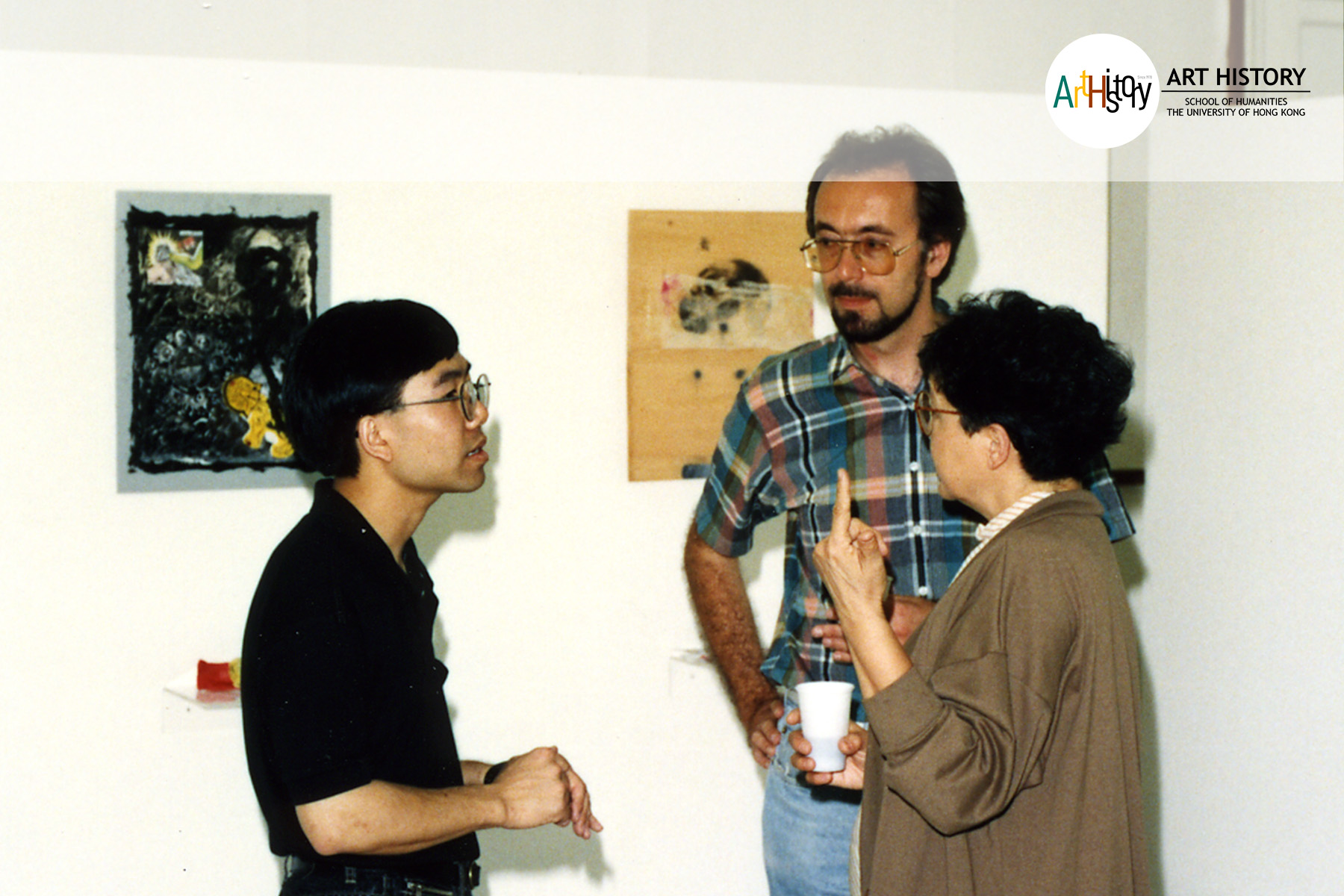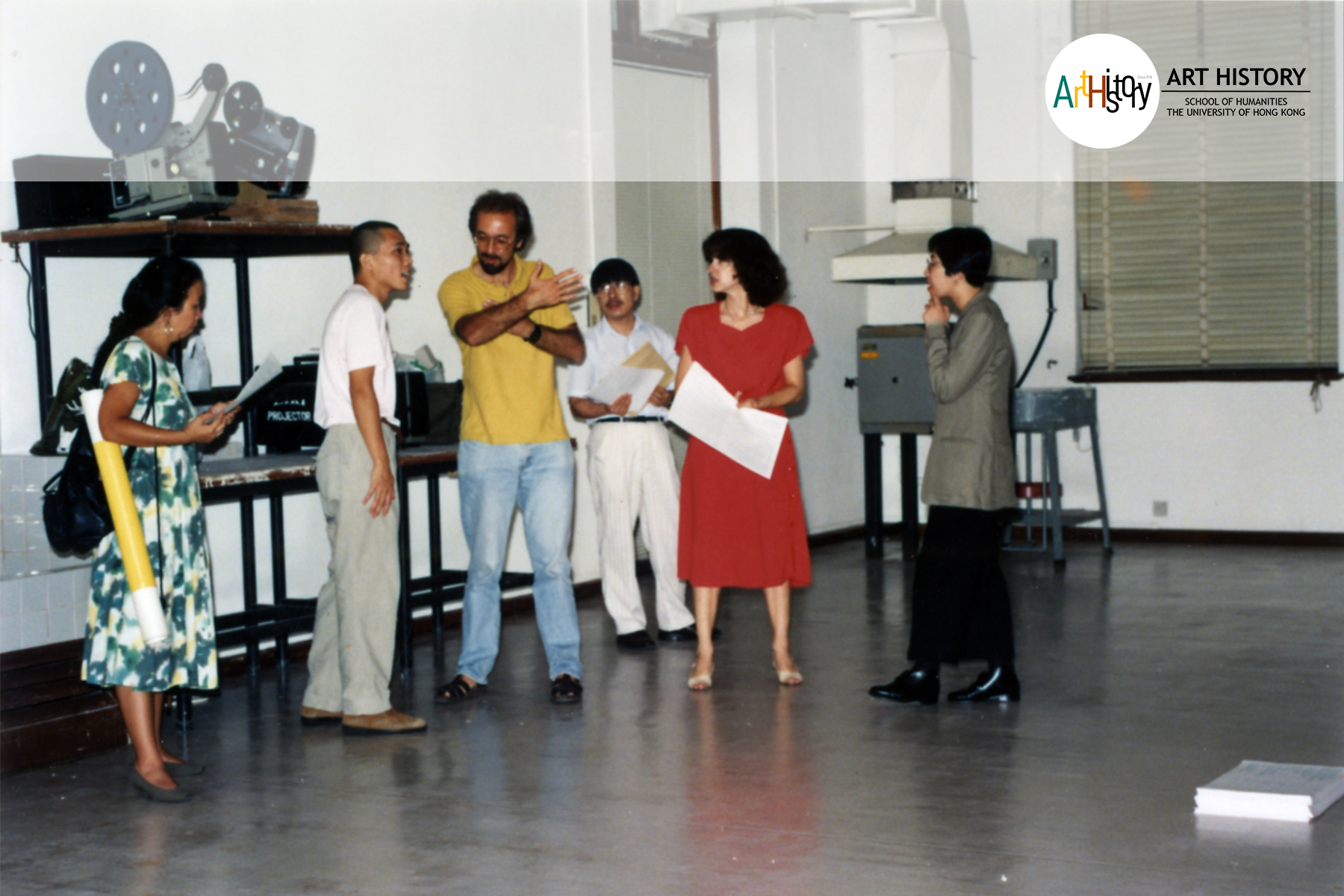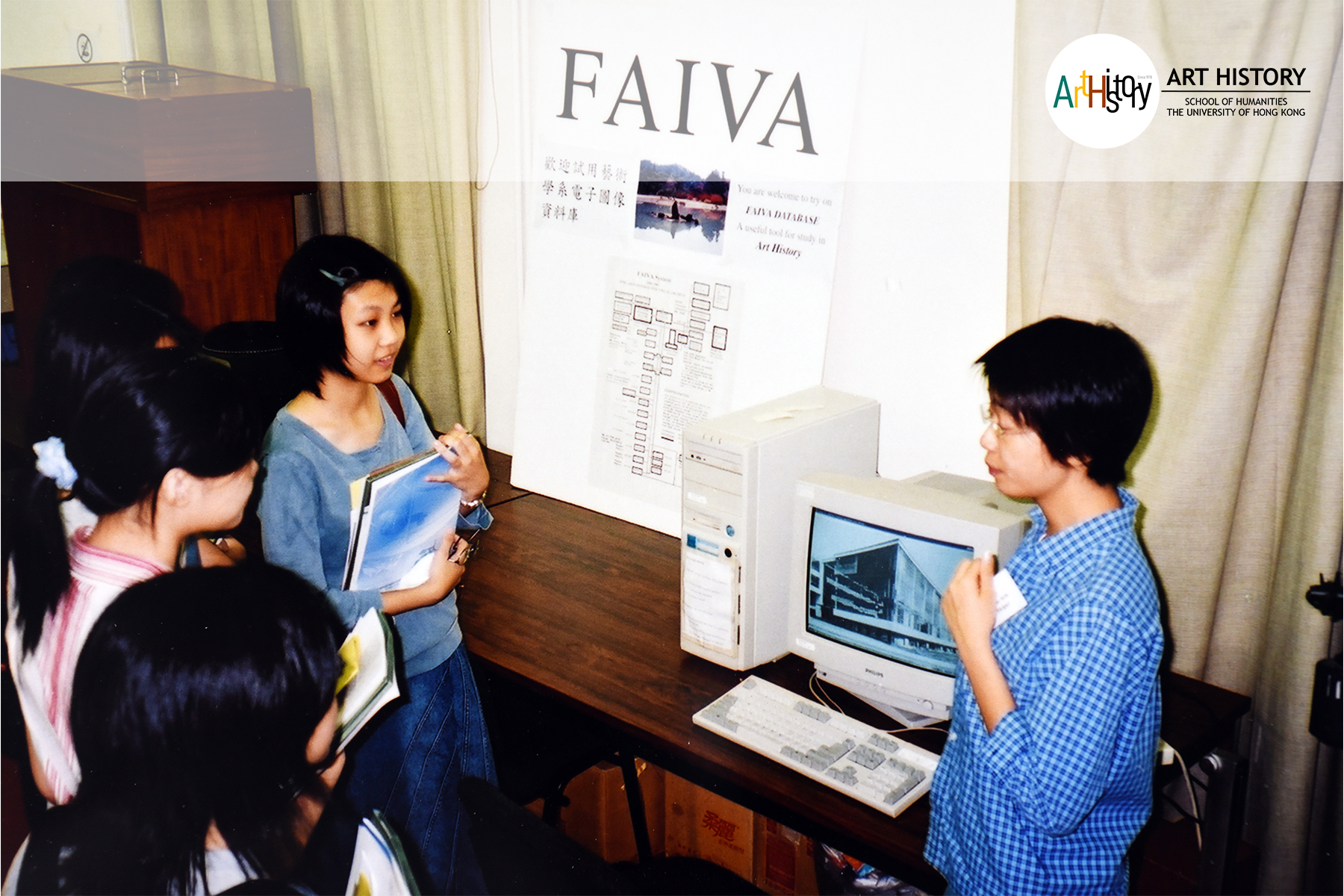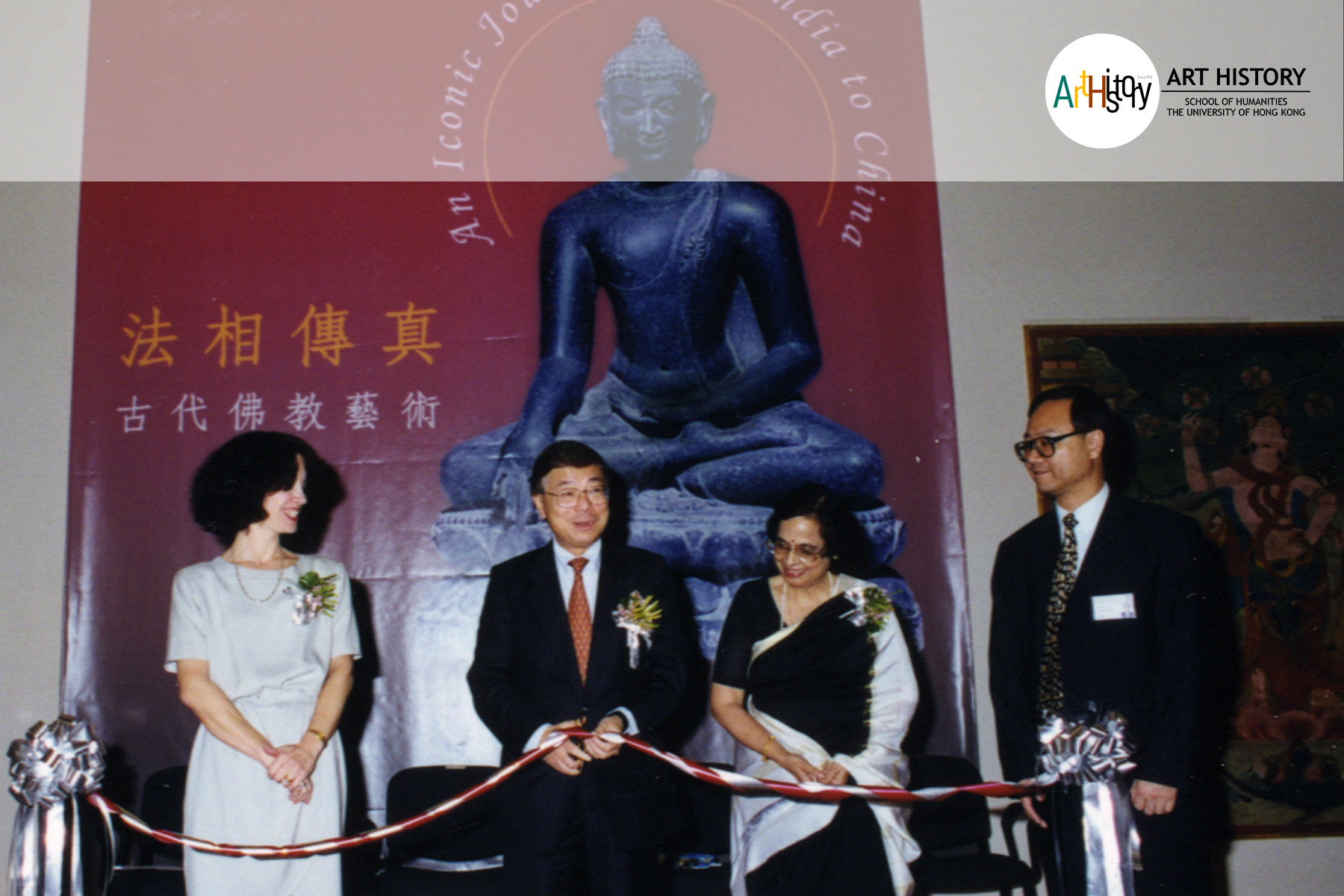1990-1991
Yan Pui Ling becomes the new Department Clerk. Shih Hsio-yen leads a field trip to India. The Department organizes three exhibitions in MB240: “Paintings and Drawings by Mei Lo”, “Artworks by Ho Siu Kee”, and “Impossible Dialogue: Drawings by Chan Wai-bong and Chan Yuk-keung” in MB240. Student numbers start to grow, with the total undergraduate enrolment reaching 99.
>> Prof. Clarke, Mr. Chan Wai Bong and Mrs. Sydney Fung at the “Impossible Dialogue: Drawings by Chan Wai-bong and Chan Yuk-keung” exhibition.

1991-1992

The Department offers its courses to Social Sciences students, its first expansion beyond the Faculty of Arts. Wan Qingli leads a field trip to China. The Department organizes an exhibition, “BODY: An Installation by Comyn Mo”, in MB240.
<< Prof. Clarke, Dr. Muir and Mr. Comyn Mo at the “BODY: An Installation by Comyn Mo” exhibition.
1992-1993
Rajeshwari Ghose joins the Department as a part-time teacher, adding courses in Indian art and Southeast Asian art to the curriculum. Shih Hsio-yen retires in March 1993, and Sydney Fung retires at the end of the academic year. The Department begins its development of the Fine Arts Interactive Visual Archive (FAIVA). Shih Hsio-yen leads a field trip to China. The Department organizes an exhibition, “KARAOKE: A Photographic Installation”, in MB240.
>> Prof. Clarke, Dr. Muir and Mr. Hiram To at the “KARAOKE: A Photographic Installation” exhibition.

1993-1994
Grace Wong is hired as the Resources Officer, and Jane Leong is appointed as Demonstrator for one year. Chow Ju-hsi rejoins the Department as its Chair Professor. With Rajeshwari Ghose having been appointed to a half-time position, the Department increases its teaching staff to 5-1/2. The Department successfully bids for funds to renovate MB238 and MB240. The Department organizes two exhibitions in the Fung Ping Shan Museum: “Sand Mandala by Rv. Monks from Nepal” and “Engaging Tradition: Violation”. Sharon Li leaves the Department.
1994-1995
The studio programme is scaled down to two courses closely linked to the two first year art history courses. The renovation of MB238 and MB240 is completed. Karen Leung joins the Department as its new Secretary, and Angela Lam as its new Demonstrator. The Department organizes an exhibition in the Fung Ping Shan Museum, “Photographs of Ajanta Murals by Benoy Behi”. By this time, student number have greatly increased, with the total undergraduate enrolment reaching 220.
1995-1996

Rajeshwari Ghose is appointed full time, giving the Department 6 full-time teachers. The Department successfully bids for a 7th post, effective from September 1996, in the area of early Chinese art. Motoaki Kono arrives as a Visiting Professor for the academic year. Chou Ju-hsi leads a field trip to Taiwan. The Department organizes an exhibition in the newly named University Museum and Art Gallery (UMAG), “Chinese Folk Art Exhibition”. The University institutes a new system of departmental majors, with 17 students choosing to major in Fine Arts. The Department is formally reviewed as part of the University’s new procedures and receives an excellent report. Choi Ju-his retires at the end of the academic year.
<< Dr. Ghose leads a field trip to India.
1996-1997
The Department is not permitted to fill the Chair Professor post, as severe budget cuts are imposed throughout the university. Wang Wen-jian joins the Department with a speciality in early Chinese art, maintaining the staffing number at 6. Angela Lam leaves the Department at the end of the academic year.
>> A Fine Arts major is introducing FAIVA to the other students on Open Day.

1997-1998
The curatorial staff of the UMAG agrees to teach a course in museum studies for the Department. Jack Lee becomes the Department’s new Demonstrator. C.T. Yeung leads a field trip to China. Rajeshwari Ghose retires from the Department at the end of the academic year. Due to the continued budgetary crunch, the Department is not allowed to fill this 6th position, and is reduced once again to 5 full-time teachers. The studio program for first year students is cancelled due to budget constraints.
1998-1999

The Department celebrates its 20th anniversary with various activities during the first semester, including a well-attended alumni dinner, the exhibition “In the Footsteps of the Buddha: An Iconic Journey from India to China” in the UMAG and a one-day international symposium of the same name. The exhibition attracts much favourable press attention, including reports in Time Magazine and the International Herald Tribune. Wang Wen-jian leads a field trip to China. The UMAG curatorial staff offer the museum studies internship for the first time.
<< The opening of “In the Footsteps of the Buddha: An Iconic Journey from India to China”.
1999-2000
The Department makes a strategic shift of direction to increase its offerings in Western art. Wang Wen-jian leaves the Department and is replaced by Greg Thomas to teach 19th century art. The UMAG curatorial staff agrees to teach courses in Chinese material culture. Pikyee Kotewall is hired part-time to teach the first year course in Chinese art. The total undergraduate enrolment continues to rise, reaching 477. Together with the Hong Kong Arts Development Council and the Chinese University of Hong Kong, the Department organizes the “Brush and Ink – International Symposium on Modern Chinese Painting” at the Hong Kong Space Museum. At the end of the first semester, Carolyn Muir resigns as Head after 11 years, staying on in the Department as Associate Professor. Richard Stanley-Baker is appointed as Head. Chuang Shen dies in August 2000 and a memorial is held in his honor.



Find us on…